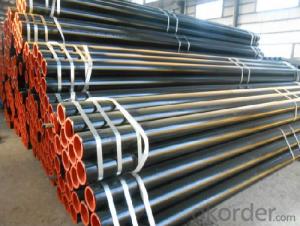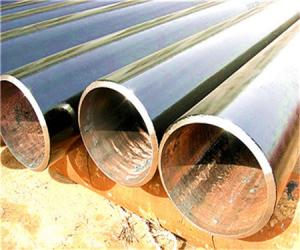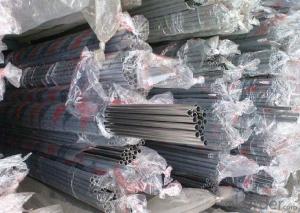Seamless Stainless Steel Tubes Steel Pipe manufacturer
- Loading Port:
- China Main Port
- Payment Terms:
- TT or LC
- Min Order Qty:
- 30 kg
- Supply Capability:
- 12000 kg/month
OKorder Service Pledge
OKorder Financial Service
You Might Also Like
1、Structure of Seamless Pipe ASTM A106/53:
Seamless pipe is formed by drawing a solid billet over a piercing rod to create the hollow shell. As the manufacturing process does not include any welding, seamless pipes are perceived to be stronger and more reliable. Historically seamless pipe was regarded as withstanding pressure better than other types, and was often more easily available than welded pipe.
Application
carbon seamless steel pipes are widely used in gas, water and oil, transpotation;constructions;Bridge,highway,windows of model steel door; building materials;fences;heating facilities Fluid Pipe;conduit pipe,scaffolding pipe.etc.
Payment Terms: L/C D/A D/P T/T
Packing and shipment
Packaged in bundles,as per customers' requirements, it can also bepackagesd as beveled ends, typed marking, black painting, plastic caps protection,woven bags packing
For 20" container the max length is 5.8m; For 40" container the max length is 12m. other options are available based on customer requests. Please discuss when placing orders.
2、Main Features of the Seamless Pipe ASTM A106/53:
• High manufacturing accuracy
• High strength
• Small inertia resistance
• Strong heat dissipation ability
• Good visual effect
• Reasonable price
3、Seamless Pipe ASTM A106/53 Specification:
Standard | GB, DIN, ASTM ASTM A106-2006, ASTM A53-2007 |
Grade | 10#-45#, 16Mn 10#, 20#, 45#, 16Mn |
Thickness | 8 - 33 mm |
Section Shape | Round |
Outer Diameter | 133 - 219 mm |
Place of Origin | Shandong, China (Mainland) |
Secondary Or Not | Non-secondary |
Application | Hydraulic Pipe |
Technique | Cold Drawn |
Certification | API |
Surface Treatment | factory state or painted black |
Special Pipe | API Pipe |
Alloy Or Not | Non-alloy |
Length | 5-12M |
Outer Diameter | 21.3-610mm |
Grade | 20#, 45#, Q345, API J55, API K55, API L80, API N80, API P110, A53B |
Standard | ASME, ASTM |
1) Material:20#(ASTM A 106/A53 GRB.API5LGRB,GB),45#,16Mn,10#.
2) Specification range:OD:21.3-610mm,WT:6-70mm,length:6-12m or according to the requirement of clients.
3) Excutive standards:GB,ASME API5L.ASTM A 106/A53,Despite of the above standards,we can also supply seamless steel pipe with standard of DIN,JIS,and so on,and also develop new products according to the requirements of our clients!
4) Surface:black lacquered,varnish coating or galvanized.
5) Ends:Beveled or square cut,plastic capped,painted.
6) Packing:bundles wrapped with strong steel strip,seaworthy packing.
4、Packaging & Delivery
Packaging Details: | seaworthy package,bundles wrapped with strong steel strip |
Delivery Detail: | 15-30days after received 30%TT |
5、FAQ of Seamless Pipe ASTM A106/53:
①How is the quality of your products?
Our products are manufactured strictly according to national and internaional standard, and we take a test
on every pipe before delivered out. If you want see our quality certifications and all kinds of testing report, please just ask us for it.
Guaranteed: If products’ quality don’t accord to discription as we give or the promise before you place order, we promise 100% refund.
②How about price?
Yes, we are factory and be able to give you lowest price below market one, and we have a policy that “ for saving time and absolutely honest business attitude, we quote as lowest as possible for any customer, and discount can be given according to quantity”,if you like bargain and factory price is not low enough as you think, just don’t waste your time.Please trust the quotation we would give you, it is professional one.
③Why should you chose us?
Chose happens because of quality, then price, We can give you both.Additionally, we can also offer professional products inquiry, products knowledge train(for agents), smooth goods delivery, exellent customer solution proposals.Our service formula: good quality+good price+good service=customer’s trust
SGS test is available, customer inspection before shipping is welcome, third party inspection is no problem.
6、Seamless Pipe ASTM A106/53 Images:
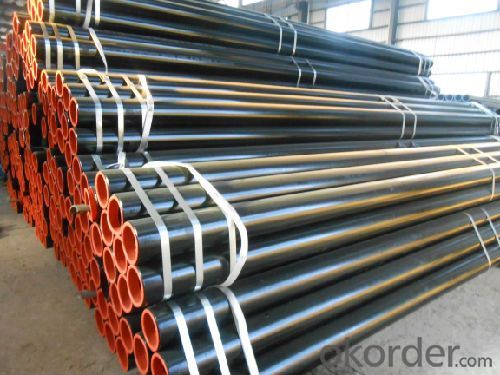
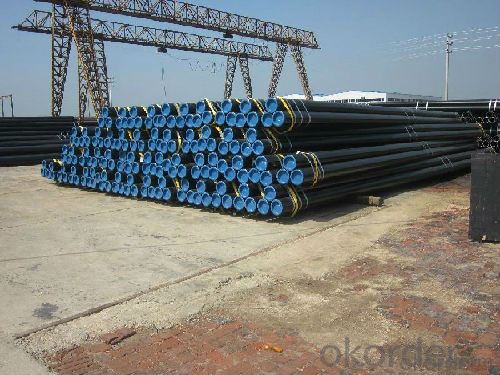
- Q:What is the difference between 321 and 321H stainless steel pipes?
- The carbon content and resulting mechanical properties are what distinguish 321 stainless steel pipes from 321H stainless steel pipes. Both grades are stabilized austenitic stainless steels with titanium as the stabilizing element. However, 321H contains a higher carbon content compared to 321. The higher carbon content in 321H contributes to enhanced strength at high temperatures and resistance to creep. This makes 321H ideal for applications involving elevated temperatures, such as the production of heat exchangers, furnace components, and other high-temperature equipment. On the contrary, 321 stainless steel pipes are commonly utilized in situations where exposure to high temperatures is not necessary. They possess excellent resistance to intergranular corrosion and are frequently employed in the aerospace industry, as well as in the manufacturing of exhaust systems, chemical processing equipment, and other versatile applications. To summarize, the distinction between 321 and 321H stainless steel pipes lies in their carbon content and resulting mechanical properties. 321H is specifically engineered for high-temperature applications, while 321 is suitable for general-purpose applications that do not require exposure to elevated temperatures.
- Q:How do stainless steel pipes compare to galvanized steel pipes?
- Stainless steel pipes and galvanized steel pipes are both commonly used in various industries and applications, but they have distinct differences in terms of their composition, properties, and performance. One of the primary differences between stainless steel and galvanized steel pipes is their composition. Stainless steel pipes are made from an alloy of iron with a minimum of 10.5% chromium content, which provides excellent corrosion resistance and durability. On the other hand, galvanized steel pipes are steel pipes that have been coated with a layer of zinc to protect them from corrosion. In terms of corrosion resistance, stainless steel pipes outperform galvanized steel pipes. The chromium content in stainless steel forms a passive layer of chromium oxide on the surface, which acts as a barrier against corrosion and rust. This makes stainless steel pipes highly resistant to pitting, crevice corrosion, and general corrosion caused by various substances and environmental factors. Galvanized steel pipes, although coated with zinc, are more susceptible to corrosion over time, especially when exposed to harsh conditions or corrosive substances. Another key difference lies in their durability and lifespan. Stainless steel pipes are known for their exceptional strength, toughness, and longevity. They can withstand high pressures, extreme temperatures, and mechanical stresses, making them suitable for demanding applications. Galvanized steel pipes, while durable, have a relatively shorter lifespan compared to stainless steel due to the eventual degradation of the zinc coating, which exposes the underlying steel to corrosion. In terms of maintenance, stainless steel pipes require minimal upkeep due to their inherent corrosion resistance. They are easy to clean and do not require regular painting or coating. On the other hand, galvanized steel pipes may require periodic inspection, maintenance, and re-coating to ensure prolonged protection against corrosion. Cost-wise, galvanized steel pipes are generally more economical upfront compared to stainless steel pipes. However, when considering the long-term benefits of stainless steel's corrosion resistance and durability, the overall cost-effectiveness of stainless steel pipes often surpasses that of galvanized steel pipes. In conclusion, stainless steel pipes offer superior corrosion resistance, durability, and longevity compared to galvanized steel pipes. While galvanized steel pipes may be more cost-effective upfront, stainless steel pipes provide long-term benefits and performance advantages, making them a preferred choice in many applications where corrosion resistance and durability are critical considerations.
- Q:What are the different types of stainless steel pipe nipples?
- A variety of stainless steel pipe nipples are available, each catering to specific industries and applications. 1. For applications requiring high strength and resistance to pressure and temperature, seamless stainless steel pipe nipples are the ideal choice. They are manufactured from a single piece of stainless steel, eliminating any welded joints. 2. Welded stainless steel pipe nipples, on the other hand, are created by joining multiple stainless steel pieces through welding. While they are more affordable than seamless nipples, their strength and durability may be slightly lower. 3. Threaded stainless steel pipe nipples feature threaded ends, making them easy to screw into place. These nipples are commonly used in plumbing and other situations where convenient installation and removal are necessary. 4. Square stainless steel pipe nipples deviate from the traditional cylindrical shape and have a square design instead. These nipples find frequent use in structural applications where stability and strength are crucial. 5. Hex stainless steel pipe nipples have hexagonal ends that provide enhanced grip for tightening and loosening. They are commonly employed in plumbing and gas supply systems. 6. Close nipples are short-length stainless steel pipe nipples with threaded ends on both sides. They are utilized for directly connecting two fittings without any gaps. 7. King nipples, also referred to as hose nipples, possess a male threaded end on one side and a barbed end on the other. These stainless steel pipe nipples are commonly found in hose assemblies for fluid transfer. 8. Reducing nipples are designed with different diameters on each end, enabling connection between pipes of varying sizes. 9. Swage nipples have one end with a larger diameter than the other. These stainless steel pipe nipples are used to transition between pipes of different sizes. 10. PEX nipples are specifically crafted for use with PEX tubing in plumbing systems. These stainless steel pipe nipples have barbed ends that securely connect to the PEX tubing. Ultimately, the choice of stainless steel pipe nipple hinges on specific requirements such as pressure, temperature, fluid compatibility, and installation method.
- Q:What is the cost difference between stainless steel and other types of pipes?
- The cost difference between stainless steel pipes and other types of pipes can vary depending on various factors such as the specific type of pipe material, size, and quality. Generally, stainless steel pipes tend to be more expensive than other types of pipes like PVC or copper due to their superior durability, corrosion resistance, and high-quality material. However, it is important to consider the long-term benefits and lifespan of stainless steel pipes, which may outweigh the initial cost difference.
- Q:How do you connect stainless steel pipes?
- To connect stainless steel pipes, there are several methods available depending on the specific requirements and applications. The most common methods include welding, threaded connections, compression fittings, and flanges. 1. Welding: Welding is the most reliable and commonly used method for connecting stainless steel pipes. It involves melting the edges of the pipes and fusing them together using a welding electrode. This creates a strong and durable joint. Different welding techniques like TIG (Tungsten Inert Gas) or MIG (Metal Inert Gas) welding can be used depending on the thickness and diameter of the pipes. 2. Threaded Connections: Threaded connections involve screwing together male and female threaded ends of the pipes using pipe thread sealant or Teflon tape. This method is suitable for smaller diameter pipes and low-pressure applications. It provides a secure connection but may not be as strong as welding. 3. Compression Fittings: Compression fittings are used when frequent disassembly is required. These fittings consist of a nut and ferrule that compresses onto the pipe when tightened. They create a tight seal and are commonly used for connecting stainless steel pipes in plumbing or gas distribution systems. 4. Flanges: Flanges are used to connect larger diameter stainless steel pipes or pipes that need to be easily assembled or disassembled. Flanges consist of two mating pieces with a gasket in between. They are bolted together, providing a strong and leak-proof connection. Flanges are commonly used in industrial applications, such as oil and gas, chemical processing, and water treatment plants. It is important to consider the specific requirements, such as pressure, temperature, and the intended application, when choosing the appropriate method to connect stainless steel pipes. Consulting with a professional or following specific guidelines and standards is recommended to ensure a safe and reliable connection.
- Q:Can stainless steel pipes be insulated with polyphthalamide?
- No, stainless steel pipes cannot be directly insulated with polyphthalamide. Polyphthalamide (PPA) is a high-performance thermoplastic that is often used as an insulating material due to its excellent thermal and electrical properties. However, PPA is typically used as a polymer or resin for injection molding applications, rather than as an insulation material for pipes. When it comes to insulating stainless steel pipes, there are several commonly used insulation materials such as fiberglass, mineral wool, or foam insulation. These materials are designed to provide thermal insulation and prevent heat transfer, while also offering protection against corrosion and condensation. If there is a need to insulate stainless steel pipes, it is best to choose an appropriate insulation material that is specifically designed for pipe insulation, rather than attempting to use polyphthalamide which is not typically used for this purpose.
- Q:What is the maximum wall thickness for stainless steel pipes?
- The specific grade of stainless steel and the intended application both play a role in determining the maximum wall thickness for stainless steel pipes. Generally, the maximum wall thickness for stainless steel pipes can range from 0.065 inches (1.65 mm) to 3 inches (76.2 mm) or possibly even more in certain instances. To ascertain the maximum allowable wall thickness for a particular application, it is crucial to refer to the relevant industry standards, codes, or specifications for the specific grade of stainless steel being utilized.
- Q:Can stainless steel pipes be used in the pharmaceutical industry?
- Yes, stainless steel pipes can be used in the pharmaceutical industry. Stainless steel is a popular choice for pharmaceutical applications due to its excellent corrosion resistance, high strength, and durability. It is resistant to many chemicals and can withstand high temperatures and pressures, making it suitable for transporting various pharmaceutical substances and fluids. Stainless steel pipes are also easy to clean and maintain, which is crucial in ensuring sanitation and preventing contamination in pharmaceutical manufacturing processes. Additionally, stainless steel is non-reactive and non-toxic, ensuring the integrity and quality of pharmaceutical products.
- Q:What color is stainless steel? What color is stainless steel pipe culture?
- Stainless steel tubes for industrial use are mostly iron gray, and civilian stainless steel is bright silver.
- Q:Are stainless steel pipes suitable for desalination plants?
- Yes, desalination plants can use stainless steel pipes. Desalination plants are facilities that are designed to remove salt and other impurities from seawater or brackish water in order to produce freshwater. In order to withstand the harsh conditions of the desalination process, which includes high pressure, high temperatures, and exposure to corrosive substances, these plants require pipes that are able to endure these conditions. Stainless steel pipes are a great choice for desalination plants because they possess inherent corrosion resistance properties. Stainless steel contains at least 10.5% chromium, which creates a thin protective oxide layer on the material's surface. This oxide layer acts as a barrier, preventing corrosion and ensuring the pipes have a long lifespan. It protects the steel from the corrosive effects of seawater, brine, and other chemicals that are used during the desalination process. Additionally, stainless steel pipes are highly durable and can withstand extreme temperatures and pressures without compromising their structural integrity. They are also resistant to scaling and fouling, which are common issues in desalination plants due to the high concentration of minerals and salts in the water. Moreover, stainless steel pipes are hygienic and easy to clean, making them a suitable choice for desalination plants that require regular maintenance and cleaning to ensure efficient and reliable operation. In conclusion, stainless steel pipes are an ideal choice for desalination plants due to their corrosion resistance, durability, and ease of maintenance. They are capable of handling the demanding conditions of the desalination process, ultimately ensuring the production of high-quality freshwater.
1. Manufacturer Overview |
|
|---|---|
| Location | |
| Year Established | |
| Annual Output Value | |
| Main Markets | |
| Company Certifications | |
2. Manufacturer Certificates |
|
|---|---|
| a) Certification Name | |
| Range | |
| Reference | |
| Validity Period | |
3. Manufacturer Capability |
|
|---|---|
| a)Trade Capacity | |
| Nearest Port | |
| Export Percentage | |
| No.of Employees in Trade Department | |
| Language Spoken: | |
| b)Factory Information | |
| Factory Size: | |
| No. of Production Lines | |
| Contract Manufacturing | |
| Product Price Range | |
Send your message to us
Seamless Stainless Steel Tubes Steel Pipe manufacturer
- Loading Port:
- China Main Port
- Payment Terms:
- TT or LC
- Min Order Qty:
- 30 kg
- Supply Capability:
- 12000 kg/month
OKorder Service Pledge
OKorder Financial Service
Similar products
New products
Hot products
Hot Searches
Related keywords
